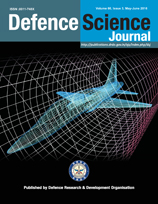A Novel CFD Method to Estimate Heat Transfer Coefficient for High Speed Flows
DOI:
https://doi.org/10.14429/dsj.66.8873Keywords:
Aerodynamic heating, heat flux, thermal analysis, computational fluid dynamics, scramjet combustorAbstract
Accurate prediction of surface temperature of high speed aerospace vehicle is very necessary for the selection of material and determination of wall thickness. For aerothermal characterisation of any high speed vehicle in its full trajectory, it requires number of detailed computational fluid dynamics (CFD) calculations with different isothermal calculations. From the detailed CFD calculations for different flow conditions and geometries, it is observed that heat transfer coefficients scale with the difference of adiabatic wall temperature and skin temperature. A simple ‘isothermal method’, is proposed to calculate heat flux data with only two CFD simulations one on adiabatic condition and other on isothermal condition. The proposed methodology is validated for number of high speed test cases involving external aerodynamic heating as well as high speed combusting flow. The computed heat fluxes and surface temperatures matches well with experimental and flight measured values.
Downloads
Published
How to Cite
Issue
Section
License
 Where otherwise noted, the Articles on this site are licensed under Creative Commons License: CC Attribution-Noncommercial-No Derivative Works 2.5 India
Where otherwise noted, the Articles on this site are licensed under Creative Commons License: CC Attribution-Noncommercial-No Derivative Works 2.5 India


